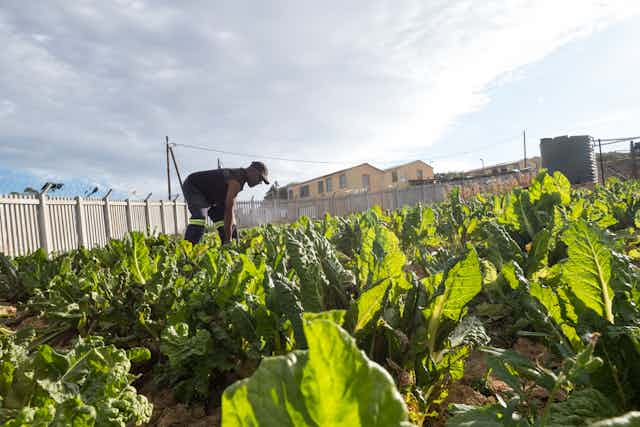In 1950, as part of the Group Areas Act, South Africa’s apartheid government banished people of colour to outlying areas, away from central business districts. The Cape Flats are one such area, sprawling to the east of central Cape Town.
Today the legacy of apartheid spatial planning endures. The area is home to several densely populated townships (low-income public housing estates) such as Khayelitsha, Gugulethu and Langa. In these communities, there’s limited infrastructure and few transport links to the city’s economic hubs.
One way in which these factors affect residents is that it’s difficult to access nutritious food. Studies reveal that there’s significant inequality in the distribution of supermarkets. Considerable distances hinder access by the urban poor to high-income areas. Additionally, supermarkets in low-income regions tend to offer less healthy food options than those in wealthier neighbourhoods.
This lack of access is reflected in levels of food insecurity across the Cape Flats. A recent study highlighted that 45% of households in the township of Gugulethu were food insecure; the figure for Khayelitsha stood at 36%. This was considerably higher than food insecurity levels in wealthier areas of Cape Town.
Urban community gardens present an opportunity to challenge the status quo. Community-centred approaches to urban agriculture have been successful in various parts of the world, including Cuba and Brazil. Communities in both countries that prioritise local distribution, school feeding schemes and hosting neighbourhood markets have experienced increased food security and improved access to nutritious foods that people not only need but prefer to eat.
Part of my PhD explored how urban community gardens could be used to improve access to nutritious food on the Cape Flats. Based on my findings, I propose a set of recommendations to encourage the selling of agro-ecologically harvested vegetables and fruits within poorer communities. The aim is to shift from the current system, where produce is primarily sold to commercial outlets, towards a more inclusive and community-centred model that directly benefits the neighbourhoods where the food is grown.
Gardeners’ stories
The City of Cape Town, the provincial department of agriculture and civil society groups have supported and promoted urban community gardens in low-income areas as a means to enhance food nutrition and security. Supporting actors help gardeners to develop their skills, as well as providing some of the required equipment. For instance, the provincial department of agriculture supports community gardens through the provision of borehole drilling, water tanks and irrigation systems.
For my research I visited 34 urban community gardens on the Cape Flats. One, in Khayelitsha, was established in February 2014 and has 11 members who tend to the day to day functioning of the garden. It stood out to me because it fostered such a strong sense of community and because the gardeners adapted to challenges as they arose.
The soil was initially poor, so the original team of 12 worked to improve its quality, using compost and manure. As the garden evolved, they decided to divide the space, allowing each individual to have their own set of plots. This structural change enhanced their harvest, enabling members to work at their own pace with a higher output. Typically the produce is sold by intermediaries who liaise with hotels and restaurants on the gardeners’ behalf. This was the case for most of the community gardens I studied: most of their harvests were sold to commercial outlets.

This current model is fundamentally flawed. It means that nutritious food produced in and by a community isn’t used to feed that community. Instead it is siphoned out to wealthier neighbourhoods and more commercial outlets.
One reason for this seems to be people’s perceptions of the quality of produce from community gardens. One garden’s co-founder told me:
The frustration that we had in the past is that people who understand that the food must be safe and nutritious is people from outside, the white or suburban people, you know, so to them there is a demand for this kind of produce. Which is a different story in our communities – here where they look down on the produce coming from the backyard and gardens and that is where we want to do a lot of education and mobilising to make sure that the produce stays locally.
Collaboration is central
I agree that such education and mobilisation is key. It dovetails with the major recommendation that emerged from my study: harvested produce from urban community gardens should be distributed through various channels – not just sold to commercial outlets. The food should be directed into local markets, community food kitchens, school feeding programmes, and directly to residents.
This ensures that urban community gardens directly contribute to the well-being and food security of the communities in which they exist.
Implementing this approach requires a collaborative effort from various stakeholders, including local governments, community organisations, and residents. It involves reshaping existing marketing strategies and policies to align with the historical and socio-economic conditions of Cape Town’s low-income areas. It also requires research to understand local consumer perspectives, dietary habits, and challenges in accessing healthy, sustainable food.
This can all be done. In Brazil, one approach to ensuring that agricultural produce from small-scale farmers reaches those who need food is to link poorer farmers with the school feeding market. The Food Acquisition Programme was initiated in 2003; it involved the government purchasing agricultural produce from impoverished farmers at set prices, storing these commodities, and subsequently distributing them to schools, crèches and NGOs. The programme is still running today.
Food justice for all
Through sustainable practices and community engagement it is possible to nurture a future in which food justice becomes a reality on the Cape Flats. Food justice is the belief that everyone should have equal access to nutritious, affordable and culturally appropriate food. It emphasises addressing social, economic and environmental factors that contribute to disparities in food access and promoting fairness in the food system.

